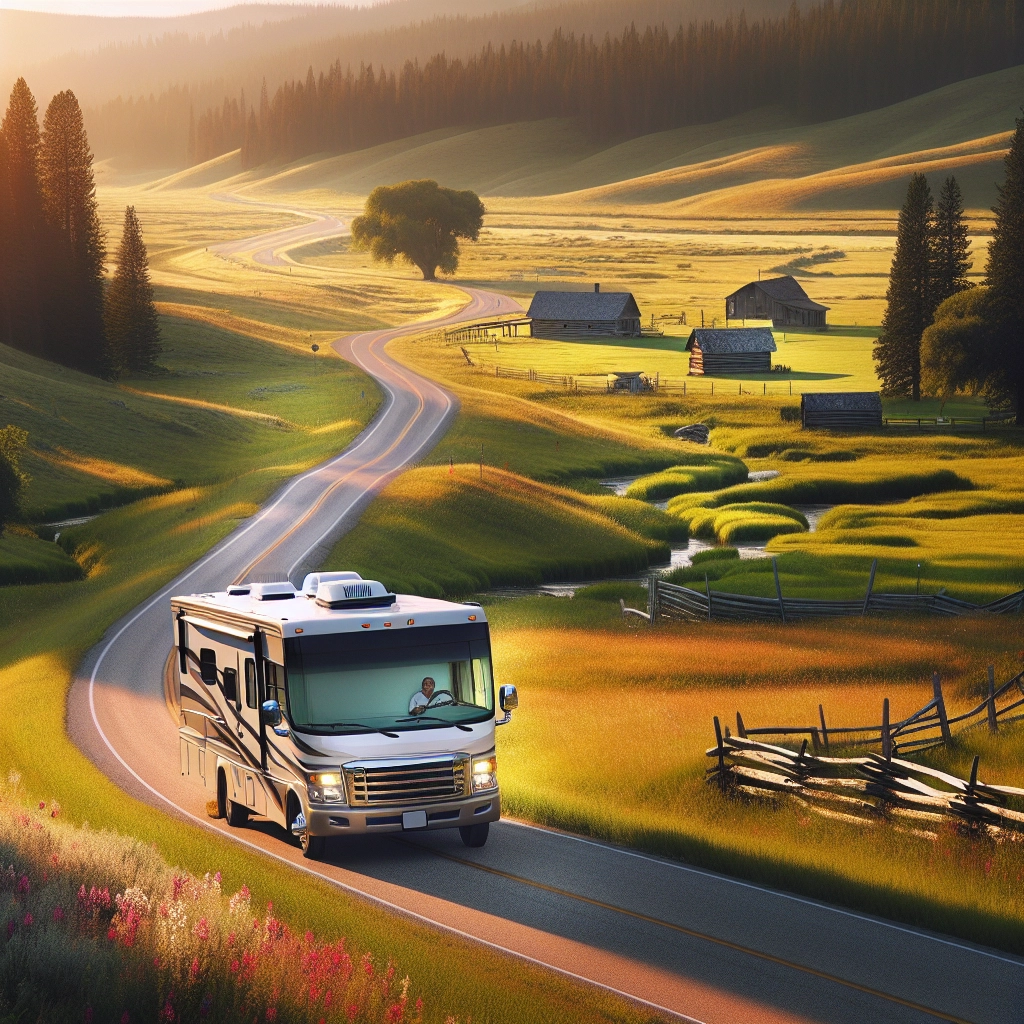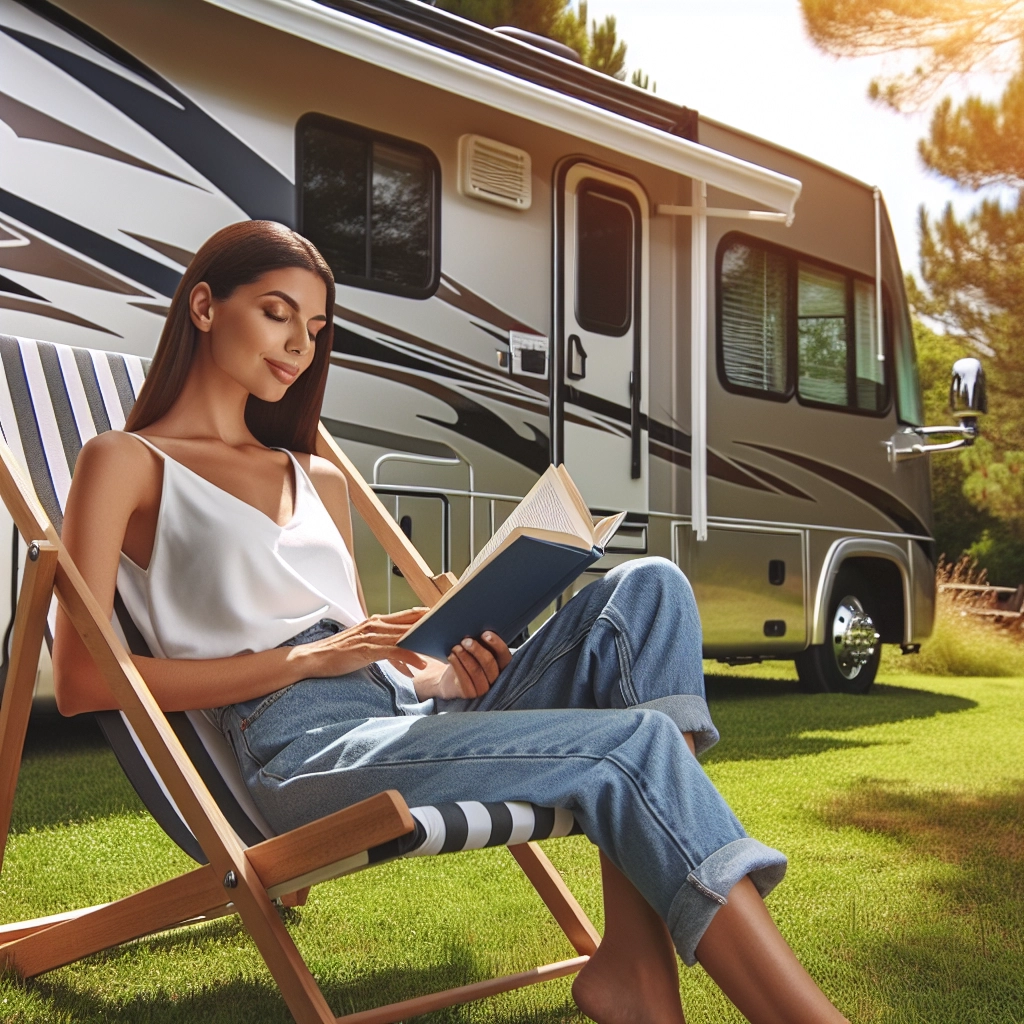Table of Contents

The Dawn of Free, Sustainable Energy for Your Motorhome Adventures
Imagine the freedom of traveling anywhere without the need to plug in for power. Solar energy is not just a trend; it’s a lifestyle shift that’s empowering RV enthusiasts to explore the great outdoors with fewer limitations. With the sun as your fuel station, every day is an opportunity to harness free, sustainable energy for your motorhome adventures.
Key Takeaways
- Solar power enables you to explore without being tethered to electrical hookups.
- Investing in solar technology can lead to significant cost savings over time.
- Using solar energy reduces your carbon footprint and helps preserve nature.
- Solar systems grant you the freedom to boondock in remote locations.
- Understanding the essential components of solar systems is key to a successful setup.
Why Solar Power is the Ultimate Game-Changer for Boondocking
Boondocking, or dry camping, is about independence and self-sufficiency. Traditional camping often relies on noisy generators or the availability of power hookups. Solar power changes the game by providing a quiet, clean, and renewable source of energy that keeps you powered up wherever you park.
Economic Benefits of Solar Energy on the Road
While the initial setup of a solar power system may seem like a sizable investment, the long-term savings are substantial. Imagine not having to pay for campsite fees just to use their electricity or constantly refueling a gas generator. Over time, the sun’s energy is essentially free, and the savings on power costs can be significant.
Environmental Impact: Leaving No Trace Behind
As an RVer, you’re naturally drawn to the beauty of the outdoors. Solar power aligns with the ‘leave no trace’ philosophy, minimizing the environmental impact of your travels. By choosing solar, you’re reducing emissions and preserving the pristine nature that you enjoy.
Freedom and Flexibility: The True Off-Grid Experience
Solar power is the ticket to true off-grid living. It allows you to stay in remote, untouched areas without the need for external power sources. This freedom to roam is what boondocking is all about, and solar energy makes it possible.

Essential Solar Components for Your Boondocking Rig
Building a reliable solar power system for your RV is like putting together the pieces of a puzzle. Each component plays a critical role in capturing, storing, and using the sun’s energy. To get started, you’ll need solar panels, batteries, a charge controller, an inverter, and a monitoring system.
Choosing the Right Solar Panels for Your Needs
Not all solar panels are created equal, and the key is to find the type that fits your specific needs. You’ll need to consider factors such as efficiency, size, weight, and durability. Monocrystalline panels are highly efficient and space-saving, making them ideal for RVs where roof space is at a premium. Polycrystalline panels, while slightly less efficient, can be a more cost-effective option. Always match the panel size and output to your energy consumption needs to ensure you have enough power to sustain your adventures.
Batteries: Your Energy Storage Solution
Batteries are the heart of your solar power system, storing the energy collected by your solar panels for later use. Deep-cycle batteries, such as AGM or lithium-ion, are preferred for RV use due to their durability and deep discharge capabilities. Lithium-ion batteries, while more expensive upfront, offer a longer lifespan and better performance, making them a smart long-term investment for serious boondockers.
Charge Controllers: Protecting Your Investment
A charge controller is essential for regulating the voltage and current coming from the solar panels to the batteries. It prevents overcharging and extends battery life. There are two main types: PWM (Pulse Width Modulation) and MPPT (Maximum Power Point Tracking). MPPT controllers are more efficient and can handle higher power inputs, making them a better choice for larger solar setups or if you plan to expand your system in the future.
Power Inverters: Converting Sunlight to Electricity
The power inverter is a critical component that converts the DC electricity stored in your batteries into AC power that can be used by your RV’s standard appliances. When selecting an inverter, ensure it has the capacity to handle the total wattage of your appliances. A pure sine wave inverter is recommended for running sensitive electronics smoothly and safely.
Monitoring Systems: Keeping an Eye on Your Power
Monitoring systems give you real-time insight into your solar power system’s performance. With a good monitor, you can track how much power you’re generating, how much you’re using, and the state of your battery charge. This information is crucial for managing your energy use and ensuring that you don’t run out of power when you need it most.
Setting Up Your Solar Power System: A Step-by-Step Guide
Installing a solar power system in your RV can seem daunting, but with the right guidance, it’s a project you can tackle with confidence. The process involves mounting the solar panels, installing the batteries and inverter, setting up the charge controller, and connecting all the components together. Let’s walk through these steps to help you get up and running.
Installation Safety: What You Need to Know First
Before you begin the installation, it’s crucial to understand the safety aspects. Always disconnect the batteries before working on the electrical system to prevent shocks. Ensure you’re working in a dry environment and use proper tools and protective gear. If you’re not comfortable with electrical systems, it’s wise to consult with a professional or an experienced fellow RVer who has done their own installation.
Securing Solar Panels: Tips for Durability and Efficiency
To get the most out of your solar panels, they need to be securely mounted and positioned to capture maximum sunlight. Use mounting brackets designed for RV roofs, ensuring they can withstand high winds and the vibrations of travel. Angle the panels to face true south if you’re in the northern hemisphere, and tilt them according to the season to optimize sun exposure. Remember, the more direct sunlight your panels receive, the more power they’ll generate.
Optimizing Battery Performance
Your batteries are where the power gets stored, so keeping them in top condition is key. First, make sure they’re properly sized for your energy needs. Keep your batteries at a moderate temperature to prevent capacity loss, and ensure they’re charged regularly to avoid sulfation, which can shorten their lifespan. If you’re using lead-acid batteries, check the water levels periodically and top them up with distilled water if needed.
Ensuring Proper Charge Controller Setup
A charge controller is like a gatekeeper for your batteries, and setting it up correctly is vital for their health. Make sure the controller’s voltage rating matches your battery bank, and position it close to the batteries to minimize voltage drop. Double-check all connections for tightness and corrosion-free terminals. A properly installed charge controller will maintain battery health and efficiency, ensuring your system runs smoothly.
Inverter Installation: Getting It Right the First Time
Installing your inverter correctly is crucial for converting DC to usable AC power. It should be placed in a dry, well-ventilated area, close to the batteries to reduce power loss in the cables. Use the correct size and length of cables to handle the expected current. Secure connections and use a fuse or circuit breaker between the inverter and battery bank for safety. A well-installed inverter will provide reliable power and peace of mind.

Maintaining Your System for Longevity and Reliability
Regular maintenance is the key to a solar power system that lasts and performs at its best. It’s not just about the initial setup; it’s about keeping each component in prime condition through the years. With a little care and attention, you can ensure your solar system remains a reliable source of power for all your boondocking adventures.
Regular Cleaning and Inspection Routines
Keep your solar panels clean and free of debris to ensure optimal performance. A simple rinse with water can do the trick, but for tougher grime, use a soft cloth or sponge and a mild detergent. Inspect your system regularly for any loose wires, corrosion, or damage, especially after long drives or extreme weather. A well-maintained panel is an efficient panel.
Battery Maintenance: Maximizing Lifespan
Battery maintenance goes beyond keeping them charged. For lead-acid batteries, ensure the electrolyte levels are adequate and the terminals are clean and tight. For all battery types, check for any signs of wear or damage, such as bulging or leaks. Keep the battery area well-ventilated to prevent gas buildup and ensure the batteries are securely mounted to minimize movement while on the road.
Troubleshooting Common Issues
Even the best solar power systems can encounter hiccups. If you find your system isn’t performing as expected, don’t worry. Start by checking the most common issues: are the solar panels clean and free of shade? Are all connections secure and corrosion-free? Is your charge controller displaying any error messages? Often, the fix is as simple as cleaning your panels or tightening a loose connection.
For battery issues, make sure they’re properly charged and not depleted beyond their recommended depth of discharge. If your inverter is not providing power, check that it’s turned on and that its input and output connections are secure. Remember, a systematic approach to troubleshooting will save you time and get you back to enjoying your off-grid adventure.
Upgrades and Scalability: Growing with Your Needs
Your solar power needs might change as you add more gadgets or decide to spend more time off-grid. The beauty of solar is that it’s scalable. You can start with a basic system and add more panels or batteries as needed. When upgrading, ensure that your charge controller and inverter can handle the increased power. It’s also a good time to reassess your energy consumption and see if there are any new energy-efficient appliances that could replace power-hungry ones.
Leveraging Solar: Maximizing the Benefits
Getting the most out of your solar setup isn’t just about having the right components; it’s also about smart energy management. By understanding how to balance energy production with consumption, you can ensure your batteries stay charged and your power needs are met. This means being mindful of how and when you use your appliances and making adjustments to your lifestyle to fit within the energy your system can provide.
Managing Power Consumption While Boondocking
When you’re boondocking, every watt counts. Monitor your energy usage and prioritize your power needs. Use natural light during the day and switch to energy-efficient LED lights at night. Charge your devices during peak sunlight hours when your panels are generating the most power. If you have high-energy appliances, consider using them sparingly or upgrading to more efficient models.
Smart Investments: Energy-Efficient Appliances and LED Lighting
Investing in energy-efficient appliances and LED lighting can significantly reduce your power consumption. These products are designed to provide the same level of performance while using less energy, which means your solar system can support more devices and last longer on a single charge. It’s a win-win for both your wallet and the environment.
The Role of Generators: Complementary or Backup?
While solar power is reliable, having a generator as a backup can provide peace of mind. Generators can be especially useful on cloudy days or when your energy demands exceed your solar production. However, they should be seen as a backup rather than a primary power source, allowing you to enjoy the benefits of solar most of the time with a generator there just in case.
Staying Connected: Solar Solutions for Digital Nomads
For those who work on the road, staying connected is crucial. Solar power systems enable digital nomads to power their devices, ensuring they can work from the most remote locations. With a well-designed solar setup, you can charge laptops, smartphones, and other gadgets, giving you the freedom to live and work wherever you choose.
The Future is Bright: Embracing Solar Power for Boondocking
As technology advances, solar power systems are becoming more efficient, more affordable, and easier to use. The trend towards sustainable living and eco-friendly travel is growing, and solar power is at the forefront of this movement. For the boondocking community, the future shines bright with the promise of extended travels, less dependency on fossil fuels, and the joy of living in harmony with nature.
FAQs About Solar Power Systems for Motorhomes
Let’s address some common questions you might have as you consider transitioning to solar power for your motorhome adventures. These answers will help you understand the basics and make informed decisions about your solar power needs.
Do solar power systems for motorhomes require special maintenance?
Solar power systems require minimal maintenance, which usually involves keeping the solar panels clean and checking the connections for corrosion or wear. Batteries may require more attention, especially if you’re using lead-acid types that need regular topping up with distilled water. Always follow the manufacturer’s guidelines for maintenance to ensure optimal performance and longevity of your system.
In conclusion, embracing solar power for your motorhome is a smart choice that pays dividends in freedom, cost savings, and environmental stewardship. As you embark on this journey, remember that every solar setup is unique, just like your adventures. Take the time to understand your needs, invest in quality components, and enjoy the peace of mind that comes with self-sufficient, clean energy. The road is open, and the sun is shining—where will you go next?
- Boondocking RVs: Flexible Solar Solutions – 3 March 2024
- Renewable Energy Tips for Full-Time Boondocking RVers – 2 March 2024
- Boondocking Solar Power Systems: Sizing Options & Solutions for Motorhomes – 1 March 2024
